Protein-coding gene in the species Homo sapiens
| PTPRB |
|---|
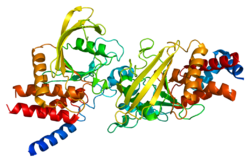 |
| Available structures |
|---|
| PDB | Ortholog search: PDBe RCSB |
|---|
| List of PDB id codes |
|---|
2AHS, 2H02, 2H03, 2H04, 2HC1, 2HC2, 2I3R, 2I3U, 2I4E, 2I4G, 2I4H, 2I5X |
|
|
| Identifiers |
|---|
| Aliases | PTPRB, HPTP-BETA, HPTPB, PTPB, R-PTP-BETA, VEPTP, protein tyrosine phosphatase, receptor type B, protein tyrosine phosphatase receptor type B |
|---|
| External IDs | OMIM: 176882; MGI: 97809; HomoloGene: 2125; GeneCards: PTPRB; OMA:PTPRB - orthologs |
|---|
| Gene location (Human) |
|---|
 | | Chr. | Chromosome 12 (human)[1] |
|---|
| | Band | 12q15 | Start | 70,515,870 bp[1] |
|---|
| End | 70,637,440 bp[1] |
|---|
|
| Gene location (Mouse) |
|---|
 | | Chr. | Chromosome 10 (mouse)[2] |
|---|
| | Band | 10|10 D2 | Start | 116,275,523 bp[2] |
|---|
| End | 116,389,535 bp[2] |
|---|
|
| RNA expression pattern |
|---|
| Bgee | | Human | Mouse (ortholog) |
|---|
| Top expressed in | - endothelial cell
- lower lobe of lung
- visceral pleura
- right lung
- right ventricle
- parietal pleura
- upper lobe of lung
- upper lobe of left lung
- epithelium of colon
- Skeletal muscle tissue of biceps brachii
|
| | Top expressed in | - right lung
- right lung lobe
- left lung
- external carotid artery
- internal carotid artery
- carotid body
- left lung lobe
- digastric muscle
- lumbar subsegment of spinal cord
- triceps brachii muscle
|
| | More reference expression data |
|
|---|
| BioGPS |  | | More reference expression data |
|
|---|
|
| Gene ontology |
|---|
| Molecular function | - protein tyrosine phosphatase activity
- phosphatase activity
- transmembrane receptor protein tyrosine phosphatase activity
- protein binding
- phosphoprotein phosphatase activity
- hydrolase activity
| | Cellular component | - integral component of membrane
- receptor complex
- integral component of plasma membrane
- membrane
- plasma membrane
- specific granule membrane
- tertiary granule membrane
| | Biological process | - phosphate-containing compound metabolic process
- protein dephosphorylation
- angiogenesis
- dephosphorylation
- peptidyl-tyrosine dephosphorylation
- neutrophil degranulation
| | Sources:Amigo / QuickGO |
|
| Orthologs |
|---|
| Species | Human | Mouse |
|---|
| Entrez | | |
|---|
| Ensembl | | |
|---|
| UniProt | | |
|---|
| RefSeq (mRNA) | |
|---|
NM_001109754
NM_001206971
NM_001206972
NM_002837
NM_001330204 |
| |
|---|
| RefSeq (protein) | |
|---|
NP_001103224
NP_001193900
NP_001193901
NP_001317133
NP_002828 |
| |
|---|
| Location (UCSC) | Chr 12: 70.52 – 70.64 Mb | Chr 10: 116.28 – 116.39 Mb |
|---|
| PubMed search | [3] | [4] |
|---|
|
| Wikidata |
| View/Edit Human | View/Edit Mouse |
|
Receptor-type tyrosine-protein phosphatase beta or VE-PTP is an enzyme specifically expressed in endothelial cells that in humans is encoded by the PTPRB gene.[5][6]
Function
VE-PTP is a member of the classical protein tyrosine phosphatase (PTP) family. The deletion of the gene in mouse models was shown to be embryonically lethal,[7] thus indicating that it is important for vasculogenesis and blood vessel development. In addition, it was shown to participate in adherens junctions complex and regulate vascular permeability.[8][9] Recently, Soni et al. have shown that tyrosine phosphorylation of VE-PTP via Pyk2 kinase downstream of STIM1-induced calcium entry mediates disassembly of the endothelial adherens junctions.[9]
Interactions
VE-PTP contains an extracellular domain composed of multiple fibronectin type_III repeats, a single transmembrane segment and one intracytoplasmic catalytic domain, thus belongs to R3 receptor subtype PTPs. The extracellular region was shown to interact with the angiopoietin receptor Tie-2[6] and with the adhesion protein VE-cadherin.[9][10]
VE-PTP was also found to interact with Grb2 and plakoglobin through its cytoplasmatic domain.
Role in disease
Dysregulation of PTPRB correlates with the development of a variety of tumors. PTPRB promotes metastasis of colorectal cancer cells via inducing epithelial-mesenchymal transition (EMT).[11]
References
- ^ a b c GRCh38: Ensembl release 89: ENSG00000127329 – Ensembl, May 2017
- ^ a b c GRCm38: Ensembl release 89: ENSMUSG00000020154 – Ensembl, May 2017
- ^ "Human PubMed Reference:". National Center for Biotechnology Information, U.S. National Library of Medicine.
- ^ "Mouse PubMed Reference:". National Center for Biotechnology Information, U.S. National Library of Medicine.
- ^ "Entrez Gene: PTPRB protein tyrosine phosphatase, receptor type, B".
- ^ a b Fachinger G, Deutsch U, Risau W (October 1999). "Functional interaction of vascular endothelial-protein-tyrosine phosphatase with the angiopoietin receptor Tie-2". Oncogene. 18 (43): 5948–5953. doi:10.1038/sj.onc.1202992. PMID 10557082.
- ^ Bäumer S, Keller L, Holtmann A, Funke R, August B, Gamp A, et al. (June 2006). "Vascular endothelial cell-specific phosphotyrosine phosphatase (VE-PTP) activity is required for blood vessel development". Blood. 107 (12): 4754–4762. doi:10.1182/blood-2006-01-0141. PMID 16514057.
- ^ Broermann A, Winderlich M, Block H, Frye M, Rossaint J, Zarbock A, et al. (November 2011). "Dissociation of VE-PTP from VE-cadherin is required for leukocyte extravasation and for VEGF-induced vascular permeability in vivo". The Journal of Experimental Medicine. 208 (12): 2393–2401. doi:10.1084/jem.20110525. PMC 3256962. PMID 22025303.
- ^ a b c Soni D, Regmi SC, Wang DM, DebRoy A, Zhao YY, Vogel SM, et al. (June 2017). "Pyk2 phosphorylation of VE-PTP downstream of STIM1-induced Ca2+ entry regulates disassembly of adherens junctions". American Journal of Physiology. Lung Cellular and Molecular Physiology. 312 (6): L1003–L1017. doi:10.1152/ajplung.00008.2017. PMC 5495943. PMID 28385807.
- ^ Nawroth R, Poell G, Ranft A, Kloep S, Samulowitz U, Fachinger G, et al. (September 2002). "VE-PTP and VE-cadherin ectodomains interact to facilitate regulation of phosphorylation and cell contacts". The EMBO Journal. 21 (18): 4885–4895. doi:10.1093/emboj/cdf497. PMC 126293. PMID 12234928.
- ^ Weng X, Chen W, Hu W, Xu K, Qi L, Chen J, et al. (April 2019). "PTPRB promotes metastasis of colorectal carcinoma via inducing epithelial-mesenchymal transition". Cell Death & Disease. 10 (5): 352. doi:10.1038/s41419-019-1554-9. PMC 6491493. PMID 31040266.
Further reading
- Ramachandran C, Aebersold R, Tonks NK, Pot DA (May 1992). "Sequential dephosphorylation of a multiply phosphorylated insulin receptor peptide by protein tyrosine phosphatases". Biochemistry. 31 (17): 4232–4238. doi:10.1021/bi00132a012. PMID 1373652.
- Harder KW, Anderson LL, Duncan AM, Jirik FR (1993). "The gene for receptor-like protein tyrosine phosphatase (PTPRB) is assigned to chromosome 12q15-->q21". Cytogenetics and Cell Genetics. 61 (4): 269–270. doi:10.1159/000133419. PMID 1486802.
- Krueger NX, Streuli M, Saito H (October 1990). "Structural diversity and evolution of human receptor-like protein tyrosine phosphatases". The EMBO Journal. 9 (10): 3241–3252. doi:10.1002/j.1460-2075.1990.tb07523.x. PMC 552056. PMID 2170109.
- Gaits F, Li RY, Ragab A, Ragab-Thomas JM, Chap H (October 1995). "Increase in receptor-like protein tyrosine phosphatase activity and expression level on density-dependent growth arrest of endothelial cells". The Biochemical Journal. 311 ( Pt 1) (Pt 1): 97–103. doi:10.1042/bj3110097. PMC 1136124. PMID 7575486.
- Feito MJ, Bragardo M, Buonfiglio D, Bonissoni S, Bottarel F, Malavasi F, Dianzani U (August 1997). "gp 120s derived from four syncytium-inducing HIV-1 strains induce different patterns of CD4 association with lymphocyte surface molecules". International Immunology. 9 (8): 1141–1147. doi:10.1093/intimm/9.8.1141. PMID 9263011.
- Nawroth R, Poell G, Ranft A, Kloep S, Samulowitz U, Fachinger G, et al. (September 2002). "VE-PTP and VE-cadherin ectodomains interact to facilitate regulation of phosphorylation and cell contacts". The EMBO Journal. 21 (18): 4885–4895. doi:10.1093/emboj/cdf497. PMC 126293. PMID 12234928.
PDB gallery
-
2ahs: Crystal Structure of the Catalytic Domain of Human Tyrosine Receptor Phosphatase Beta -
2h02: Structural studies of protein tyrosine phosphatase beta catalytic domain in complex with inhibitors -
2h03: Structural studies of protein tyrosine phosphatase beta catalytic domain in complex with inhibitors -
2h04: Structural studies of protein tyrosine phosphatase beta catalytic domain in complex with inhibitors -
2hc1: Engineered catalytic domain of protein tyrosine phosphatase HPTPbeta. -
2hc2: Engineered protein tyrosine phosphatase beta catalytic domain -
2i3r: Engineered catalytic domain of protein tyrosine phosphatase HPTPbeta -
2i3u: Structural studies of protein tyrosine phosphatase beta catalytic domain in complex with inhibitors -
2i4e: Structural studies of protein tyrosine phosphatase beta catalytic domain in complex with inhibitors -
2i4g: Structural studies of protein tyrosine phosphatase beta catalytic domain in complex with a sulfamic acid (soaking experiment) -
2i4h: Structural studies of protein tyrosine phosphatase beta catalytic domain co-crystallized with a sulfamic acid inhibitor -
2i5x: Engineering the PTPbeta catalytic domain with improved crystallization properties |
 | This article on a gene on human chromosome 12 is a stub. You can help Wikipedia by expanding it. |

 2ahs: Crystal Structure of the Catalytic Domain of Human Tyrosine Receptor Phosphatase Beta
2ahs: Crystal Structure of the Catalytic Domain of Human Tyrosine Receptor Phosphatase Beta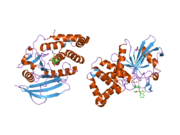 2h02: Structural studies of protein tyrosine phosphatase beta catalytic domain in complex with inhibitors
2h02: Structural studies of protein tyrosine phosphatase beta catalytic domain in complex with inhibitors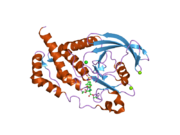 2h03: Structural studies of protein tyrosine phosphatase beta catalytic domain in complex with inhibitors
2h03: Structural studies of protein tyrosine phosphatase beta catalytic domain in complex with inhibitors 2h04: Structural studies of protein tyrosine phosphatase beta catalytic domain in complex with inhibitors
2h04: Structural studies of protein tyrosine phosphatase beta catalytic domain in complex with inhibitors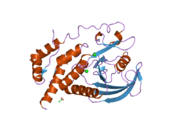 2hc1: Engineered catalytic domain of protein tyrosine phosphatase HPTPbeta.
2hc1: Engineered catalytic domain of protein tyrosine phosphatase HPTPbeta. 2hc2: Engineered protein tyrosine phosphatase beta catalytic domain
2hc2: Engineered protein tyrosine phosphatase beta catalytic domain 2i3r: Engineered catalytic domain of protein tyrosine phosphatase HPTPbeta
2i3r: Engineered catalytic domain of protein tyrosine phosphatase HPTPbeta 2i3u: Structural studies of protein tyrosine phosphatase beta catalytic domain in complex with inhibitors
2i3u: Structural studies of protein tyrosine phosphatase beta catalytic domain in complex with inhibitors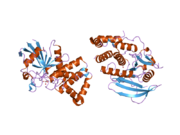 2i4e: Structural studies of protein tyrosine phosphatase beta catalytic domain in complex with inhibitors
2i4e: Structural studies of protein tyrosine phosphatase beta catalytic domain in complex with inhibitors 2i4g: Structural studies of protein tyrosine phosphatase beta catalytic domain in complex with a sulfamic acid (soaking experiment)
2i4g: Structural studies of protein tyrosine phosphatase beta catalytic domain in complex with a sulfamic acid (soaking experiment)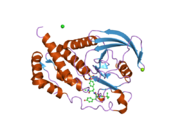 2i4h: Structural studies of protein tyrosine phosphatase beta catalytic domain co-crystallized with a sulfamic acid inhibitor
2i4h: Structural studies of protein tyrosine phosphatase beta catalytic domain co-crystallized with a sulfamic acid inhibitor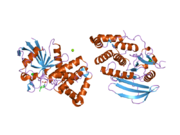 2i5x: Engineering the PTPbeta catalytic domain with improved crystallization properties
2i5x: Engineering the PTPbeta catalytic domain with improved crystallization properties






























